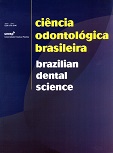Discrepâncias de assentamento ocorridas em copings cerâmicos confeccionados pelos sistemas IPS Empress 2 e In-Ceram, variando-se os términos cervicais e os agentes cimentantes: estudo in vitro
DOI:
https://doi.org/10.14295/bds.2009.v12i4.637Abstract
Este trabalho avaliou as adaptações cervicais de copings cerâmicos, confeccionados pelos Sistemas Empress 2 e In-Ceram, variando-se os términos cervicais dos preparos em chanfro largo e ombro 90° arredondado; em preparos com 15° de conicidade, e 2 tipos de agentes para cimentação: o cimento de fosfato de zinco e um cimento resinoso. Foram confeccionados dois modelos-padrão de aço inoxidável. A partir destes obtiveram-se 40 troquéis em gesso tipoV, sendo 20 para cada sistema e 10 para cada tipo de término cervical e os copings cerâmicos correspondentes para cada sistema. Em seguida, o conjunto foi levado ao metroscópio horizontal para a primeira leitura (L0). Procedeu-se a cimentação, inicialmente sob pressão digital, em seguida com a aplicação de carga padronizada e efetuou-se a segunda medida (L1). Após a coleta dos dados, foi realizada a análise estatística das médias das medidas aferidas e as seguintes conclusões foram alcançadas: a) o cimento de fosfato apresentou um valor médio de discrepância de assentamento, para os dois sistemas, menor do que o resinoso; b) término cervical em chanfro e ombro arredondado, para qualquer um dos sistemas, mostraram resultados semelhantes; c) o sistema In-Ceram apresentou um valor médio de discrepância assentamento menor que o IPS Empress 2, porém não significante estatisticamente.
Downloads
Downloads
Published
How to Cite
Issue
Section
License
Brazilian Dental Science uses the Creative Commons (CC-BY 4.0) license, thus preserving the integrity of articles in an open access environment. The journal allows the author to retain publishing rights without restrictions.
=================




























